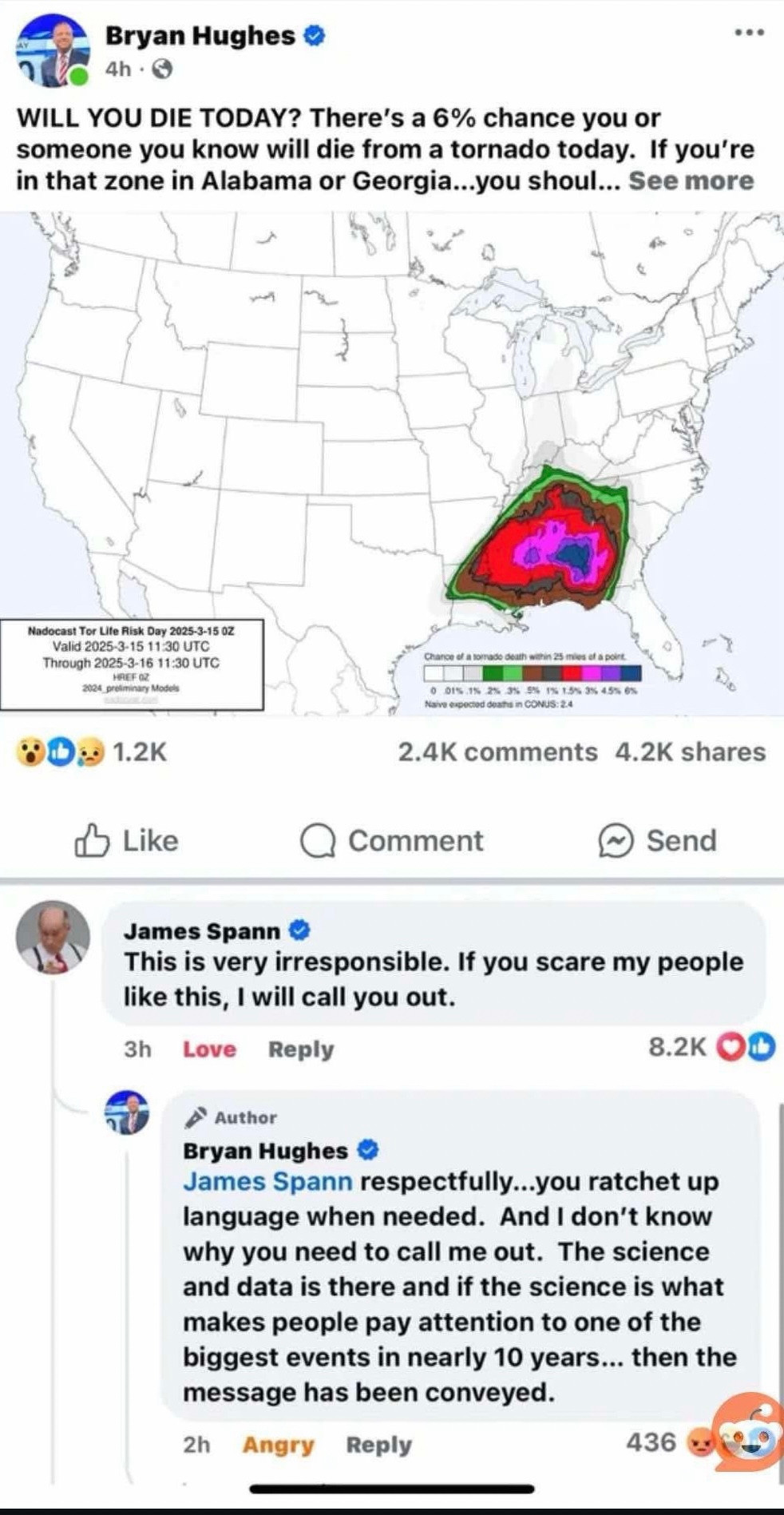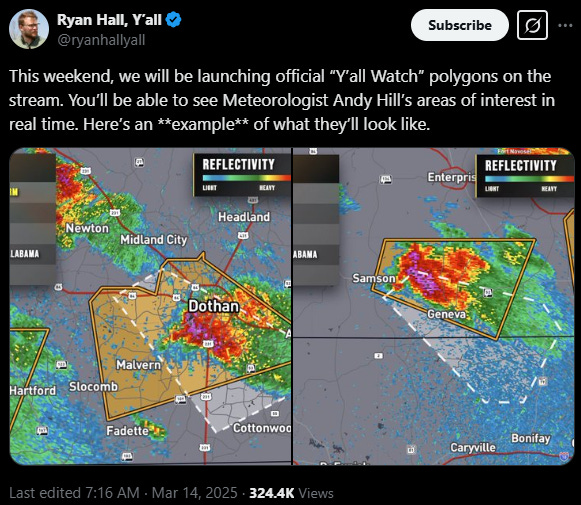As severe weather season ramps up, the communication strategy across meteorology is as messy as ever
At least NOAA's Storm Prediction Center remains the gold standard
Severe weather season is underway, and yesterday brought a few examples of how messy our ability to communicate effectively is becoming.
One of the biggest complaints I see via social media and hear from people at large is the tendency for media hype to make every event out to be the worst event ever. I used to sort of brush that aside; I generally agreed, but having worked as a broadcast meteorologist, I’m keenly aware that sometimes people hear what they want to hear and not what you’re actually saying. So, having been there and knowing a lot of broadcast meteorologists personally, I felt (and still do to an extent) that they deserve the benefit of the doubt. Throughout the 2010s, well before “misinformation” became a daily part of the vernacular, meteorologists were having to deal with what we derisively called “social mediarologists,” or independent weather wonks, typically hobbyists that would hype up events because they learned it got them engagement and an audience. But in the last couple years, something has changed. It started with a handful of professional meteorologists that joined the chorus of voices hyping up events on social media. It transitioned to broadcasters doing the same. Today, instead of “social mediarologists” hyping events we have them, a number of professionals, random non-weather related influencers, and the YouTube class all doing this.
Will you die today?
Yesterday, a very well-advertised “high risk” day by the SPC showed a good example of this.
Putting aside what on earth the formula is for determining that one has six percent odds that “you or someone you know will die today” from a tornado, I think we need to be introspective here and ask “is this necessary?” Their argument that “if this is what makes people pay attention” then great is one I have heard often from a lot of people ahead of almost any major event. But here’s the rub: We have a scale, a very good 1 through 5 scale in fact that the SPC provides us with. As meteorologists, we read their discussions, look at the data ourselves, and we can determine how we want to communicate that. There is not any value on the scale greater than 5, and that’s for a reason. If we have to go overboard on the messaging to get people to pay attention when they’re in a level 5 of 5 already, then what’s the point of having the scale at all? Or is it for engagement and our own standing as communicators and influencers today? The problem with the line of thinking that something needs to be taken overboard to the absolute extreme (when it already is there) is that it waters down that extreme. It also detracts from our ability as a profession to communicate. “He said we have a high risk, but there was no mention of the six percent chance of dying this time, so I guess this isn’t as bad.” You see where I’m going here? I’m not an academic expert at communication, but I’d like to think I’m good at it and I’ve learned a thing or two over the years by doing this constantly.
Independent “areas of interest”
Then there’s this from Ryan Hall, Y’all. This one gets to a very, very slippery slope.
If you’ve ever spoken to a meteorologist, which many of you probably have not, you would know that this individual elicits opinions. Passionate ones. Many in our field loathe his work. Some are passively supportive. A small handful are vocally supportive. His audience is rabidly passionate about what he does. To me, his work is an enigma. On the one hand, he does what we want communicators in this field to do: He reaches people, they listen; to them he is an independent voice they feel they can trust. Those are facts, and no one in our field can dispute that.
One look at his YouTube channel (which incidentally has 2.5 million followers) and my head wants to explode. Watching his videos, which I’ve done a couple times, and they aren’t as bad as the ALL CAPS OMG headlines would imply. And there are times where I don’t think his discussions are entirely on the point. I’m going to generalize here, but my assumption is that because of legacy media generally faltering in the 21st century, and the subsequent erosion of trust in the monolithic “them,” rightly or wrongly, he is finding a niche for people to gravitate toward. To those people, The Weather Channel is too corporate, too focused on climate change, doesn’t show enough weather. Whatever their reasons are, even if they’re misleading or unfair, this individual reaches them and fills the void that they feel they’ve been missing.
But when we start talking about “issuing polygons,” that gets dangerously close to sending a mixed message and trying to play the role of the National Weather Service. Remember, these are people that are aiming to get eyeballs, viewers, engagement. Yes, they may want to help and just reach people. But at the end of the day, they also want to get paid. So, will these “Y’all Watches” be a way of trying to predict where the next real tornado warning gets issued. I mean, I do that during severe weather events myself, and in the Houston area, I will flag certain storms that may be close to warning level for people. “Hey, keep an eye on this one.” If that’s the case, great. Or are these “watches” meant to keep you watching? Only time will tell. But I think anyone criticizing this or arguing that it’s potentially dangerous is correct. His viewers? Almost certainly will approve of this. But if you go this route, the burden is on you to prove the rest of us wrong.
Which brings us back to the first point about legacy media types. In this environment, where you have a wildly successful independent influencer, what are you supposed to do? Keep on keeping on the way it’s always been while you continue to lose audience share? Hope that we come out of this environment where the loudest voices get the most attention? Or, if you can’t beat them, join them? In our case with Space City Weather and The Eyewall, we’re content with slow, steady growth and the understanding that people will shop around for information but ultimately turn to us when they want a level-headed opinion or forecast. Is that the right way? Most “traditionalists” would probably tell you, yes. And as a science communicator, to me that’s the right way to do things. But clearly when someone non-traditional enters the fray and has success (and Ryan Hall is not the only one capitalizing on this), it does beg the question of how you get through to that audience. Or should you even try? One thing for sure, trying to mimic that approach in a traditional realm is going to give you (and a lot of the rest of us) headaches. I think we need to understand what is working well before we even try to think about emulating it in any aspect. Curious what others think of this, especially non-meteorologists.
Another reason to support NOAA
Digressing a bit, I thought about publishing this over at The Eyewall, but this borders a bit heavy on advocacy. We’ve done our NOAA pitch as it relates to hurricanes, and we’ll continue to advocate for NOAA because it’s important for everyone that we do. But I want to just take a minute to recognize another NOAA agency, the Storm Prediction Center.
Most people that are moderately weather-aware would know the SPC fairly well. They’re the ones that issue severe weather outlooks and watches for severe thunderstorms and tornadoes. They also issue critically important outlooks for wildfire. This has been very true recently here in Texas, which is currently transitioning into a tinderbox. We aren’t California, but we’re not doing great at the moment! Anyway, they’re an incredibly important cog in the weather-wheel.
They issued their first high risk of 2025 yesterday, and they did a really good job overall. They did a lot of work this weekend, and it went well. To some, yesterday “felt” like a bust. It really wasn’t, and with over 30 fatalities from severe weather this weekend, I can only imagine how much worse it would have been without their work ahead of the storms. They constantly do work like this, and it almost always works out. I am consistently impressed by the level of expertise that’s housed at the SPC in Norman, OK. These are the sharpest minds in severe weather meteorology, and they prove it time and again. They deserve to remain fully funded and staffed for the good of public safety. This is especially true in a world with loud voices, mixed motives, and pressure to deliver engagement metrics.







